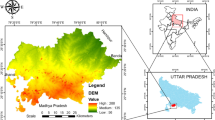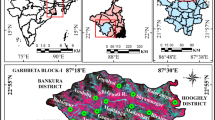Abstract
The purpose of this study is to understand soil loss due to rain runoff and its relation to soil geoelectrical properties influencing vulnerability of soils. The relationship between soil geoelectric properties and rain runoff-based soil loss estimation is important to plan for soil and water conservation practices for a better agricultural development in the project area. The resistivity sounding method used to determine the soil thickness and textural variations. Based on geo-resistivity data, the depth of soil was found shallow (0.30–0.80) m in the upper regions and reaches up to 2.9 m in low-lying areas along the channels and structurally weaker/fractured zones. The sandy clay loam of the central part of the study area has corrosive to highly corrosive tendencies due to resistivity between 20 and 48 Ω m. Based on RUSLE model the mean estimated annual average soil loss value is 15.63 t/ha year, while in terms of soil cover thickness loss, it is 0.63 mm/ha year. The average soil cover loss is low (0.42 mm/ha year) in sandy clay loam, while high (2.1 mm/ha year) in sandy loam. It has been found that 7.1% study area has no soil loss risk. The 46.3% of the study area falling under the least soil loss limit, 27.8% under low risk of soil loss, 12.1% under medium risk of soil loss, 4.3% under high risk of soil loss, and 2.4% are at severe risk of soil loss. We concluded sites having the coarse texture and shallow soil depth owing a resistivity > 48 Ω m must prioritized for soil conservation activities at these sites.








Similar content being viewed by others
References
Aaltonen J (2001) Seasonal resistivity variations in some different swedisch soils. Eur J Environ Eng Geophys 6:33–45
Aubele JC, Crumpler LS, Elston WE (1988) Vesicle zonation and vertical structure of basalt flows. J Volcanol Geoth Res 35:349–374. https://doi.org/10.1016/0377-0273(88)90028-5
Banton O, Cimon MA, Seguin MK (1997) Mapping field-scale physical properties of soil with electrical resistivity. Soil Sci Soc Am J 61:1010–1017. https://doi.org/10.2136/sssaj1997.03615995006100040003x
Bayowa OG, Olayiwola NS (2015) Electrical resistivity investigation for topsoil thickness, competence and corrosivity evaluation: a case study from Ladoke Akintola University of Technology, Ogbomoso, Nigeria. Paper presented at the 2nd international conference on geological and civil engineering, Singapore
Biswas SS, Pani P (2015) Estimation of soil erosion using RUSLE and GIS techniques: a case study of Barakar River basin, Jharkhand. India Model Earth Syst Environ 1:42. https://doi.org/10.1007/s40808-015-0040-3
Buvat S, Thiesson J, Michelin J, Nicoullaud B, Bourennane H, Coquet Y, Tabbagh A (2014) Multi-depth electrical resistivity survey for mapping soil units within two 3 ha plots Geoderma 232–234:317–327 https://doi.org/10.1016/j.geoderma.2014.04.034
CGWB (2010) Ground water informations Jalna District Maharashtra. Central Ground Water Board, Nagpur
Challa O, Mandal C (2005) Soil resources based land use of Jalna District, Maharashtra. vol NBBS Publ-122. National Bureau of Soil Survey and Land Use Planning, Nagpur
Descloitres M, Ribolzi O, Troquer YL, Thiébaux JP (2008) Study of water tension differences in heterogeneous sandy soils using surface ERT. J Appl Geophys 64:83–98. https://doi.org/10.1016/j.jappgeo.2007.12.007
Duraiswami RA, Das S, Shaikh T (2012) Hydrogeological framework of aquifers in the Deccan traps. Some Insights Memoir Geological Society of India, India, pp 1–15
Duraiswami RA, Gadpallu P, Shaikh TN, Cardin N (2014) Pahoehoe—a′a transitions in the lava flow fields of the western Deccan Traps, India—implications for emplacement dynamics, flood basalt architecture and volcanic stratigraphy. J Asian Earth Sci 84:146–166. https://doi.org/10.1016/j.jseaes.2013.08.025
Fernandez C, Wu JQ, McCool DK, Stockle CO (2003) Estimating water erosion and sediment yield with GIS, RUSLE and SEDD. J Soil Water Conserv 58:128–136
Fu G, Chen S, McCool DK (2006) Modeling the impacts of no-till practice on soil erosion and sediment yield with RUSLE, SEDD, and ArcView. GIS Soil Tillage Res 85:38–49. https://doi.org/10.1016/j.still.2004.11.009
Ganasri BP, Ramesh H (2016) Assessment of soil erosion by RUSLE model using remote sensing and GIS—a case study of Nethravathi. Basin Geosci Front 7:953–961. https://doi.org/10.1016/j.gsf.2015.10.007
Gelagay HS, Minale AS (2016) Soil loss estimation using GIS and remote sensing techniques: a case of Koga watershed, Northwestern Ethiopia. Int Soil Water Conserv Res 4:126–136. https://doi.org/10.1016/j.iswcr.2016.01.002
Goldman SJ, Jackson K, Bursztynsky TA (1986) Erosion and sediment control handbook. McGraw Hill Book Co., New York
Goyal VC, Gupta PK, Seth SM, Singh VN (1996) Estimation of temporal changes in soil moisture using resistivity method. Hydrol Process 10:1147–1154 https://doi.org/10.1002/(sici)1099-1085(199609)10:9%3C1147::aid-hyp366%3E3.0.co;2-s
Idornigie AI, Olorunfemi MO, Omitogun AA (2006) Electrical resistivity determination of subsurface layers, subsoil competence and soil corrosivity at and engineering site location in Akungba-Akoko, southwestern Nigeria Ife. J Sci 8:159–177
Igboekwe MU, Eke AB, Adama JC, Ihekweaba G (2012) The Use of Vertical Electrical Sounding (VES) in the Evaluation of Erosion in Abia State University, Uturu and Environs The Pacific. J Sci Technol 13:509–520
Islam T, Chik Z, Mustafa MM, Sanusi H (2012) Estimation of soil electrical properties in a multilayer earth model with boundary element. Formul Math Probl Eng 2012:13. https://doi.org/10.1155/2012/472457
John UJ, Igboekwe MU, Amos-Uhegbu C (2015) Geophysical evaluation of erosion sites in some parts of Abia State. Southeastern Nigeria. Phys Sci Int J 6:66–81
Kouli M, Soupios P, Vallianatos F (2009) Soil erosion prediction using the Revised Universal Soil Loss Equation (RUSLE) in a GIS framework, Chania, Northwestern Crete, Greece. Environ Geol 57:483–497. https://doi.org/10.1007/s00254-008-1318-9
Kumar D, Rao VA, Nagaiah E, Raju PK, Mallesh D, Ahmeduddin M, Ahmed S (2010) Integrated geophysical study to decipher potential groundwater and zeolite-bearing zones in Deccan. Traps Curr Sci 98:803–814
Lim KJ, Sagong M, Engel BA, Tang Z, Choi J, Kim K-S (2005) GIS-based sediment assessment tool. CATENA 64:61–80. https://doi.org/10.1016/j.catena.2005.06.013
Limaye SD (2010) Review: groundwater development and management in the Deccan Traps (basalts) of western India. Hydrogeol J 18:543–558. https://doi.org/10.1007/s10040-009-0566-4
Maury S (2015) Spatial modeling of ground water potential in parts of South Andaman Island, India—an integrated approach of remote sensing and geophysical techniques. PhD, Pondicherry University
Maury S, Balaji S (2014) Geoelectrical method in the investigation of groundwater resource and related issues in Ophiolite and Flysch formations of Port Blair, Andaman Island. India Environ Earth Sci 71:183–199. https://doi.org/10.1007/s12665-013-2423-y
Michot D, Benderitter Y, Dorigny A, Nicoullaud B, King D, Tabbagh A (2003) Spatial and temporal monitoring of soil water content with an irrigated corn crop cover using surface electrical resistivity tomography. Water Resour Res. https://doi.org/10.1029/2002wr001581
Miller RB, Heeren DM, Fox GA, Halihan T, Storm DE, Mittelstet AR (2014) The hydraulic conductivity structure of gravel-dominated vadose zones within alluvial floodplains. J Hydrol 513:229–240. https://doi.org/10.1016/j.jhydrol.2014.03.046
Millward AA, Mersey JE (1999) Adapting the RUSLE to model soil erosion potential in a mountainous tropical watershed. CATENA 38:109–129. https://doi.org/10.1016/S0341-8162(99)00067-3
Molnár DK, Julien PY (1998) Estimation of upland erosion using GIS. Comput Geosci 24:183–192. https://doi.org/10.1016/S0098-3004(97)00100-3
Morse MS, Lu N, Godt JW, Revil A, Coe JA (2012) Comparison of soil thickness in a zero-order basin in the Oregon Coast Range using a soil probe and electrical resistivity tomography. J Geotech Geoenviron Eng 138:1470–1482. https://doi.org/10.1061/(asce)gt.1943-5606.0000717
Naik PK, Awasthi AK, Anand A, Mohan PC (2001) Hydrogeologic framework of the Deccan terrain of the Koyna River basin. India Hydrogeol J 9:243–264. https://doi.org/10.1007/s100400100123
Panagos P, Jones A, Bosco C, Kumar PSS (2011) European digital archive on soil maps (EuDASM): preserving important soil data for public free access. Int J Digital Earth 4:434–443. https://doi.org/10.1080/17538947.2011.596580
Pozdnyakova L, Pozdnyakov A, Zhang R (2001) Application of geophysical methods to evaluate hydrology and soil properties urban areas. Urban Water 3:205–216. https://doi.org/10.1016/S1462-0758(01)00042-5
Renard KG, Foster GR, Weesies GA, McCool DK, Yoder DC (1997) Predicting soil erosion by water: a guide to conservation planning with the Revised Universal Soil Loss Equation (RUSLE). Agriculture Handbook No. 703. USDA-ARS
Robain H, Descloitres M, Ritz M, Atangana QY (1996) A multiscale electrical survey of a lateritic soil system in the rain forest of Cameroon. J Appl Geophys 34:237–253. https://doi.org/10.1016/0926-9851(95)00023-2
Roberge PR (ed) (2006) Corrosion basics: an introduction. 2nd edn. NACE Press Book
Samouëlian A, Cousin I, Tabbagh A, Bruand A, Richard G (2005) Electrical resistivity survey in soil science: a review. Soil Tillage Res 83:173–193. https://doi.org/10.1016/j.still.2004.10.004
Sharda VN, Mandal D, Ojasvi PR (2013) Identification of soil erosion risk areas for conservation planning in different states of India. J Environ Biol 34
Sjödahl P, Dahlin T, Johansson S, Loke MH (2008) Resistivity monitoring for leakage and internal erosion detection at Hällby embankment dam. J Appl Geophys 65:155–164. https://doi.org/10.1016/j.jappgeo.2008.07.003
Sudha K, Israil M, Mittal S, Rai J (2009) Soil characterization using electrical resistivity tomography and geotechnical investigations. J Appl Geophys 67:74–79. https://doi.org/10.1016/j.jappgeo.2008.09.012
Tabbagh A, Dabas M, Hesse A, Panissod C (2000) Soil resistivity: a non-invasive tool to map soil structure horizonation. Geoderma 97:393–404. https://doi.org/10.1016/S0016-7061(00)00047-1
Wall GJ, Coote DR, Pringle EA, Shelton IJ (2002) RUSLEFAC—revised universal soil loss equation for application in Canada: a handbook for estimating soil loss from water erosion in Canada. vol Contribution No. AAFC/AAC2244E. Research Branch, Agriculture and Agri-Food Canada, Ottawa
Weihnacht B, Börner F (2007) Multi-method geophysical measurements for soil science investigations in the vadose zone. Hydrol Earth Syst Sci Discuss 2007:2659–2681. https://doi.org/10.5194/hessd-4-2659-2007
Wischmeier WH, Smith DD (1978) Predicting rainfall erosion losses - a guide to conservation planning. Agriculture Handbook No. 537. US Department of Agriculture Science and Education Administration, Washington, DC, USA
Wischmeier WH, Johnson C, Cross B (1971) Soil erodibility nomograph for farmland and construction sites. J Soil Water Conserv 26:189–192
Xie Y, Li X, Zhang F, Wang Y (2015) Detection of soil thickness in forest land based on electrical resistivity tomographic scanning technology. Trans Chin Soc Agric Eng 31:212–216
Yamakawa Y, Kosugi K, Masaoka N, Sumida J, Tani M, Mizuyama T (2012) Combined geophysical methods for detecting soil thickness distribution on a weathered granitic hillslope. Geomorphology 145–146:56–69 https://doi.org/10.1016/j.geomorph.2011.12.035
Zhou QY, Shimada J, Sato A (2001) Three-dimensional spatial and temporal monitoring of soil water content using electrical resistivity tomography. Water Resour Res 37:273–285. https://doi.org/10.1029/2000wr900284
Zhou P, Luukkanen O, Tokola T, Nieminen J (2008) Effect of vegetation cover on soil erosion in a mountainous watershed. CATENA 75:319–325 https://doi.org/10.1016/j.catena.2008.07.010
Acknowledgements
This research work has been jointly supported by the Watershed Organisation Trust and the Hindustan Unilever Foundation. The first author is thankful to Dr. S. Balaji professor of Department of Disaster Management, Pondicherry University, Mr. Nishat Ahmed of Groundwater Survey Development Agency for their critical reviews and discussion. The first author is also thankful to the GeoExTerra™ Geophysical Exploration and Terrain Technology Private Limited, New Delhi for providing extended support for improving this manuscript. All author to extend their thanks to Pravin Jogdande and Lala Savare for their help during geophysical survey and field logistics. The views expressed in this work are those of the author and do not necessarily represent those of the Watershed Organisation Trust and the Hindustan Unilever Foundation.
Author information
Authors and Affiliations
Corresponding author
Additional information
Publisher’s Note
Springer Nature remains neutral with regard to jurisdictional claims in published maps and institutional affiliations.
Rights and permissions
About this article
Cite this article
Maury, S., Gholkar, M., Jadhav, A. et al. Geophysical evaluation of soils and soil loss estimation in a semiarid region of Maharashtra using revised universal soil loss equation (RUSLE) and GIS methods. Environ Earth Sci 78, 144 (2019). https://doi.org/10.1007/s12665-019-8137-z
Received:
Accepted:
Published:
DOI: https://doi.org/10.1007/s12665-019-8137-z




